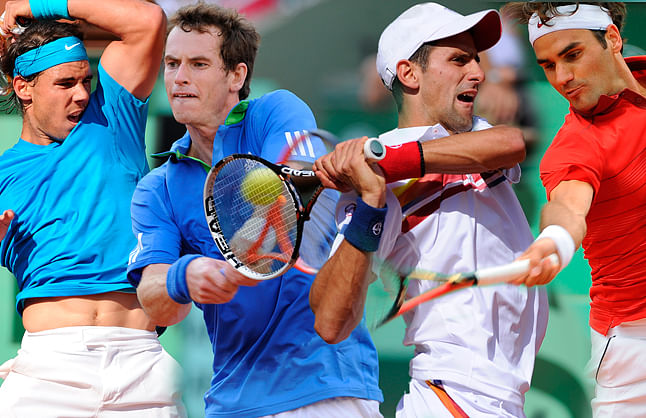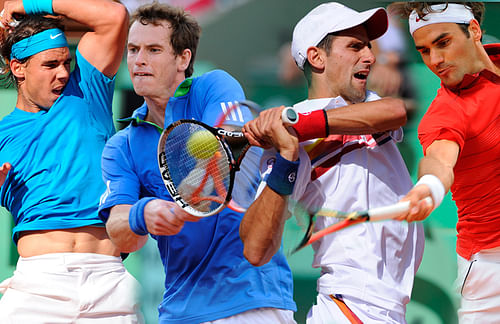
Has the Big Four era in Men’s Tennis truly ended?

When Rafael Nadal lost to Stanislas Wawrinka in the final of the 2014 Australian Open, the murmurs started. When Roger Federer suffered an early exit at the hands of Andreas Seppi at the 2014 Wimbledon, the chatter started. After he suffered a crushing defeat to Marin Cilic who went on to win the 2014 US Open, eulogies were written. The last four months of the previous season and the first couple of months of this season have rendered the talk premature. But was it premature even back then? Has the stranglehold of the Big Four truly ended?
Is the dominance of the Big Four Over-rated?
This couldn’t be further from the truth. Comprised of Roger Federer, Rafael Nadal, Novak Djokovic and Andy Murray, the Big Four has dominated tennis for the best part of the last decade. Prior to Wawrinka winning the 2014 Australian Open, the Big Four had won 34 of the previous 35 grand slam titles. The outlier being the 2009 US Open which was won by Juan Martin Del Potro. In the period 2009-2013, the Big Four won 19 of 20 grand slam titles and 14 of the 20 finals saw two members of the Big Four. Their dominance is not limited to the grand slams alone. Since the ATP rebranded 9 tournaments as the “Masters 1000” in 2009, the Big Four have won 47 of 54 tournaments and in the last 4 years it is an even more dominant 33 of 36. Such has been their stranglehold on the game that the only person outside of Big Four to win a grand slam title and a Masters 1000 tournament was Wawrinka, who won the Australian Open and the Monte-Carlo Masters in 2014. No person outside of the Big Four has multiple Masters 1000 titles.
Why have the Big Four dominated?
No other quintet has dominated men’s tennis like these four men. Each one has a different style, but the results are equally emphatic. While improved racket technology, convergence of court speeds and new sports regimens have definitely helped, the truth is that they are freakish athletes who are extremely gifted and have made the necessary sacrifices to have a successful career in tennis. It also helps to have a serve like Federer, a forehand like Nadal, a backhand like Djokovic or the guile of Murray. Another reasons for their dominance is adaptability. Irrespective of the surface, their footwork is precise, shot selection is perfect and will to win is unmatched. They also have the unique ability to peak at the right time in the grand slams.
Why do people feel they are washed up?
2014 was slightly different to the previous 5 years. The “second line”, as coined by Marin Cilic, had a second wind. Entering the Australian Open final, Wawrinka had lost 12 straight matches to Nadal without winning a set. That stat changed within the first 30 minutes of the final as Wawrinka blew away Nadal in the first set before the latter suffered a back injury at the beginning of the second set. The injury affected the match and it only a question of when rather if Wawrinka would win. As Wawrinka hoisted his first grand slam titles, the world wondered if this was the beginning of the end of an era.
Back issues troubled Federer throughout 2013 as he slipped to No. 7 in the rankings. Murray had back surgery during the 2013 off-season and was still finding his feet. Nadal’s back injury troubled him for longer than expected. Later in the year, Nadal and Federer suffered early exits at Wimbledon. With Nadal out for rest of the year and Murray struggling for form, the “second line” ceased their opportunity as Marin Cilic won the US Open. The era of the Big Four was over and it was time for the “second line” proclaimed many.
Has the dominance truly ended?
After a down year in 2013, Federer enjoyed a renaissance in 2014. He made it to the final of the Wimbledon and World Tour Finals and semi-finals of the Australian Open and US Open. He won 2 Masters 1000 titles also. Despite playing only half the season, Nadal won the French Open and made it to the final of the Australian Open. Djokovic won Wimbledon, World Tour Finals and four Masters 1000 titles. He also made it to the finals of the French Open. While it was a down year compared to their lofty standards, it was still better than any of the members of the “second line”. Wawrinka suffered a dip in form after success in the early part of the year. Kei Nishikori had a consistent year and was unlucky not to win the Madrid Masters. Thomas Berdych and Milos Raonic were consistent, but failed to win any of the big tournaments. Juan Martin Del Potro was ruled out for much of the year due to the recurrence of his wrist injury.
While many people suspect that age might be catching up with the Big Four, the “second line” is not getting any younger. Berdych and Wawrinka are going to be 30 next year and only Federer is older than them. Djokovic, Federer and Nadal ended the year another year as the top 3 in the rankings. Djokovic and Federer started the 2015 season as strongly as they ended the 2014 season. The former has won the Australian Open while the latter has won the Dubai Championships.
While 2015 dint quite start off like 2014, there might be surprises lying in wait. We might be seeing the end of an empire, but the emperors have not relented just yet.